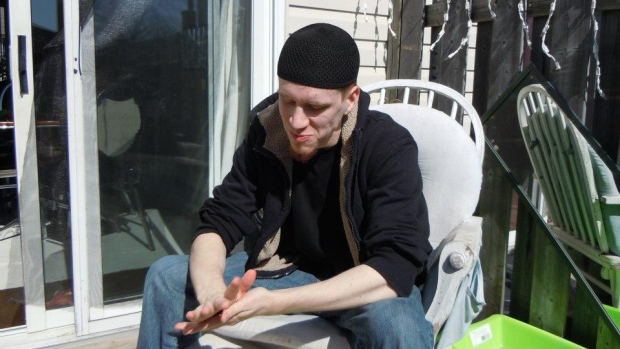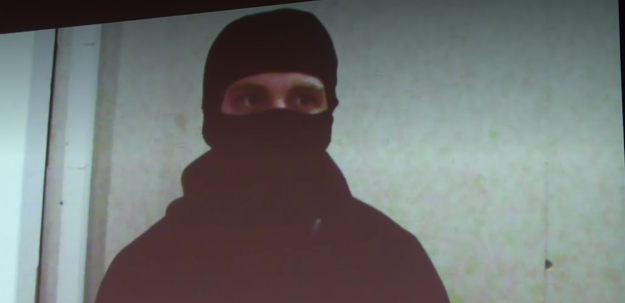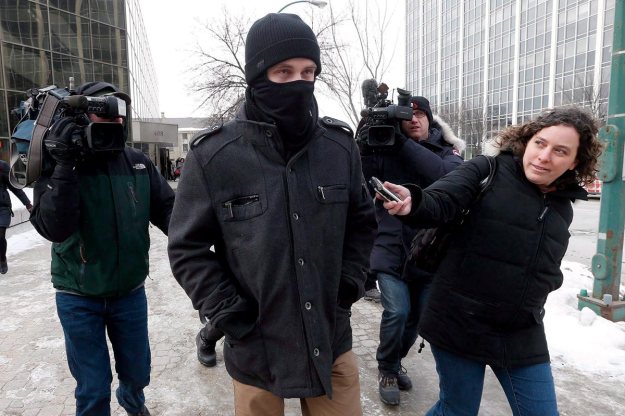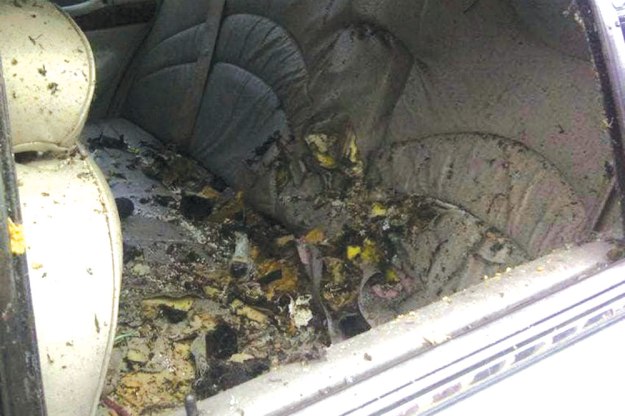By Kyle Orton (@KyleWOrton) on August 16, 2016

On 10 August 2016, Aaron Driver, 24, detonated a bomb in the back of a taxi in Strathroy, Ontario, Canada, as the Royal Canadian Mounted Police (RCMP) closed in, wounding himself and the driver before the police opened fire and killed him. A convert and long-time supporter of the Islamic State—Driver was arrested for such support in June 2015—Driver had followed the pattern of many recent operatives of the Islamic State by making a martyrdom video declaring his allegiance to the caliph, Abu Bakr al-Baghdadi, which was sent to the IS “news agency” Amaq in preparation for his impending terrorism. This was among the communications intercepted by the FBI.
In the video, Driver says:
O Canada, you received many warnings. You were told many times what will become of those who fight against the Islamic State. You watched as your allies in Europe and America had their bullets and bombs returned back to them. You saw bodies of the filthy French laying in their own streets.
You saw explosions in Paris and Brussels, similar to the explosions they were dropping on citizens of the Islamic State. You saw brave men and women respond to the call of jihad. You saw that each member of the coalition of crusaders was being punished for their aggression against the Muslims. Then, perhaps, you found yourself safe from retaliation because you ran away from the battlefield. No, no by Allah you still have much to pay for.
You still have a heavy debt which has to be paid. You still have Muslim blood on your hands, and for this we are thirsty for your blood. There’s a fire burning in the chest of every Muslim, and this fire can be cooled only by the spilling of your blood. Your war on Islam is not the kind of crime we allow ourselves to dismiss, to forgive, or to forget, inshallah.
You will pay for everything you ever brought against us. Whether you drop a bomb or fire a single bullet, we will hold you accountable for this, inshallah. Whether you spend millions in the war against Islam or you spend a single cent, we will hold you accountable, inshallah.
When you creep an inch towards the lands of Islam or you set foot over its boundaries, we will hold you accountable, inshallah.
You call yourselves peacekeepers on this Earth, but Allah has already warned us against you. You’re nothing but mischief-makers, and all you do is spread oppression and corruption. So today is the day you experience what it’s like to be targeted for your belief, inshallah.
I give my pledge of allegiance to Abu Bakr al-Baghdadi, Emir al-Mumineen (Commander of the Faithful), who’s called for jihad in the lands of crusaders, and I respond to this call.

Aaron Driver bay’a video
On 11 August 2016, Amaq claimed Driver as one of their own:
Source to Amaq Agency: “The executor of the attack targeting police in Canada was a soldier of the Islamic State and carried out the operation in response to calls to target coalition countries.”
Reuters produced a timeline of Driver’s life:
December 2014: Canada’s Royal Canadian Mounted Police launch an investigation they call Project Sumo after receiving a complaint about social media posts by a man named Aaron Driver, then 23 years old and living in Winnipeg, Manitoba.
February 2015: The Toronto Star interviews Driver, and publishes a story without using his name. Driver, who says he converted to Islam at 17, says “in some ways I was pretty excited” when a gunman attacked Canada’s parliament in 2014, but also criticizes Islamic State for glorifying violence in hostage videos. Driver says he has been interviewed by the Canadian Security Intelligence Service, and knows they are monitoring him. After he is killed, the Star names Driver as the person in the interview.
April 2015: The RCMP discovers that Driver is communicating with several people of concern, including Junaid Hussain, a British hacker who U.S. and European officials have said became a top cyber expert for Islamic State in Syria before he was killed in a drone strike, and Reyaad Khan, who the RCMP describe as a prominent member of Islamic State.
May 2015: According to police, American Elton Simpson messages Driver and six other people on Twitter hours before Simpson participates in an attack on a Texas exhibit of caricatures of the Prophet Mohammad [run by Pamela Geller].
June 4, 2015: The RCMP arrests Driver for knowingly participating in the activities of a terrorist group, and find a recipe for homemade explosives on his computer. He is released on bail later that month wearing an electronic monitoring device, under a peace bond which says he cannot apply for a passport, among other conditions.
February 2016: Driver agrees to a new peace bond that does not require electronic monitoring and prosecutors agree not to go to trial.
July 2016: Driver moves from Manitoba to his sister’s house in Strathroy, Ontario, about 225 km (140 miles) southwest of Toronto.
8:30 a.m., Aug. 10, 2016: The FBI gives the RCMP a video showing a masked man threatening an imminent attack on a major Canadian city, RCMP Assistant Commissioner Jennifer Strachan said. U.S. and Canadian authorities do not immediately know who is shown in the video or where he lives.
11 a.m., Aug. 10, 2016: Canadian investigators decide that the man in the video is likely Aaron Driver, and send officers to his house.
4:30 p.m., Aug. 10, 2016: Driver leaves his sister’s house in Strathroy and gets into a cab. He detonates a homemade bomb, injuring the cab driver. Aaron Driver dies, killed by either his own explosive device or a shot fired by police.
That it ended like this for Driver is hardly a surprise.
Driver first caught the attention of Canada’s intelligence services in October 2014. Born to a Christian family in Regina on 18 August 1991, Driver’s mother died when he was seven-years-old; his father continued to work on the land for a few more years on the farm where they lived before they moved to New Brunswick, Ontario and Alberta. Driver’s father joined the joined the Canadian Forces and Driver says he never connected with his father or the woman he remarried. In 2012, Driver, his father, and step-mother moved to Manitoba. Somewhere between 2011 and 2012, Driver converted to Islam. By the fall of 2014, Driver, tweeting under the name “Harun Abdurahman” had attracted significant attention and Driver’s father was presented with the evidence of his son’s radicalization. “Some things made me want to throw up,” the father said. “People beheaded—he’s commenting on them like it’s some big joke, and he’s applauding their actions. There was a picture of Christian kids being assassinated, and he said they deserved it.” By March 2015, the father said, “He’s gone, he’s lost, I can’t help him”. Driver was arrested in June 2015 because of the fear he would get involved in domestic terrorism: “Eight days later, he was released on numerous bail conditions requiring him to undergo religious counselling, stay away from social media and wear an electronic monitoring device. ‘I feel like I’m living in a prison now, you know, without having access to the internet,’ he said.”
In June 2015, Driver, then-23 and living in Winnipeg, spoke to the Canadian Broadcasting Corporation (CBC) and told them quite plainly of his support for the Islamic State and terrorism. Of the assault on Parliament Hill in Ottawa by Michael Zehaf-Bibeau, mere days after the Islamic State’s spokesman Taha Falaha (Abu Muhammad al-Adnani) had called for attacks by Muslims within the West, Driver said: “If a country goes to war with another country or another people or another community, I think that they have to be prepared for [crimes like that committed by Zehaf-Bibeau]… [T]hey shouldn’t act surprised. They had it coming for them; they deserved it.”
“In February 2016, although he wasn’t facing criminal charges, Driver agreed to a peace bond to limit his activities. The peace bond meant that Driver could take off the GPS monitoring bracelet and he wouldn’t have to get religious counselling, but there were many other conditions. He had to continue living in Ontario, where he had been staying with his brother. He would also need written permission to own any cellphones, computers or mobile devices. As well, he agreed to stay off social media websites until the end of August.”
Driver defied these orders: “Driver … had made a ‘martyrdom video’ and was planning an attack within 72 hours in an urban centre during morning or afternoon rush hour. Driver, 24, was under a peace bond for communicating with what the RCMP called well-known ISIS supporters in the U.K. and the U.S.”
Thus, Driver was not a “lone wolf”: he was a guided operative of the Islamic State. And Driver serves also as a refutation of those who believe that the Islamic State claims every attack: Driver failed, and yet still he was claimed by the Islamic State, because he was acting at their instruction and on their behalf.
UPDATE
On 19 January 2017, Lauren McKeon had an extended profile of Aaron Driver. It paints a picture of a man who never quite got on track. His mother, Linda, died of brain cancer when he was five; his father, Wayne, a devout Christian, remarried a woman called Monica when Aaron was nine, and Aaron never did really accept it. Aaron turned against religion altogether.
Aaron “ran away, often for days at a time. Sometimes he’d go to friends’ houses, but, most of the time, Wayne had no idea where he was. One day, when Aaron was 14, Wayne found disturbing poetry hidden in his son’s room. Aaron had fantasized about stabbing his dad and stepmom in their sleep, placing plastic bags over their heads and strangling them, cutting their brake lines, even burning down the house. They were terrified. Wayne installed a lock on their bedroom door.”
At sixteen-years-of-age, Aaron “announced he wanted to live in a group home for troubled teenage boys. To everyone’s surprise, Aaron thrived in the group home. He was a model resident—he did his chores, kept curfew, completed his homework. Two years after he moved in, he began dating a young woman he’d met through friends. Within a few months, they discovered she was pregnant. Aaron was ecstatic. He was young—just 18 at the time—but he was determined to be a good dad. Aaron saw fatherhood as his chance to build the family he’d always wanted. He dropped out of school and got a job. He and his girlfriend moved into an apartment in London [Ontario], where they decorated a nursery for the baby. He also began studying the Bible and attending church with Eileen. But something wasn’t right: he wasn’t connecting with Christianity. Aaron was scouring YouTube for religious debates when he stumbled upon a video of Muslim theologians criticizing Christianity. Fascinated, he fell into a rabbit hole, devouring dozens of YouTube videos about Islam. He was drawn to the Muslim scholars who, he felt, ideologically destroyed their opponents. His new faith developed in an online silo … The day he was set to take his shahada—the formal testament of faith that would mark his conversion to Islam—his girlfriend went into labour. Their son, Seth, was stillborn, the umbilical cord wound tightly around his neck. Aaron was shattered. … He was only 19, gawky and pimple-faced, and already he’d buried his mother and his son. Islam was all he had left. He took his shahada a week later. Aaron’s relationship with his girlfriend didn’t survive the death of their child.”
Driver got very deeply involved with the baqiyah family, the online supporters of the Islamic State, some of whom were directly linked to the organization. Twitter cracked down on the Islamic State’s presence in the summer of 2014, but Driver was already within the Islamic State’s networks on Kik, WhatsApp, and Telegram, and he had already acted as a propagandist-recruiter, drawing in “a teen in the Maritimes who hung out with a rough crowd and did drugs” and “a 14-year-old in the U.K. who later helped plan support for an ISIS attack against Australian police officers from his bedroom.” Living in a basement apartment in Winnipeg and working at a distribution warehouse:
Over the next year [i.e. between mid-2014 and mid-2015], he befriended some of ISIS’s most zealous supporters online. He bonded with Elton Simpson … The two exchanged their last tweets just hours before the shooting, which Simpson signalled with the hashtag #texasattack. Authorities believe that Aaron helped Simpson encrypt his messages, though his involvement was never proven. After the attack, Aaron tweeted, “I think this worked out beautifully.” As his devotion to ISIS intensified, he became convinced that all members of the military were justified targets. …
Every so often, the self-styled jihadi warrior went off-message, and flashes of another Aaron appeared. His Twitter feed featured a surprising number of cute kitten Vines and YouTube videos sprinkled among the hate speech and gleeful gloating. He loved to talk about weight-lifting and workouts …
In February 2015, Wayne was reading a Toronto Star interview with a masked ISIS supporter named Harun Abdurahman. … When Wayne read the interview, he knew immediately that Harun was Aaron. … A few weeks later, he had coffee with a Canadian Security Intelligence Service agent who told him CSIS was on a fact-finding mission focused on his son. The intelligence agency had been monitoring Aaron’s online behaviour since October 2014. He was flagged after he retweeted “Sharpen your knife”—a call from Canadian ISIS supporter John Maguire to his fellow Canuck jihadists. CSIS had been trying to determine how deep in the organization Aaron was and whether there was a chance he’d act on his beliefs.
Wayne … didn’t grasp the extent of Aaron’s loyalty to ISIS … until the agent slid a thick file folder across the coffee-shop table. It contained all of Aaron’s Twitter and Facebook communications. Wayne flipped through the pictures Aaron was liking and sharing: babies in mass graves, beheadings, bombings—one horrific act of violence after another. He made it through about 10 pages before he broke down in tears. As soon as he got home, he called Aaron’s mosque in Winnipeg and asked for help. The mosque tried to arrange meetings with Aaron and paired him with a peer mentor, hoping to deradicalize him. Aaron wouldn’t listen to anybody but his baqiyah.
He knew he was being watched. CSIS was calling his friends, his relatives, an ex-girlfriend, and he’d seen RCMP officers monitoring his house. Aaron welcomed their surveillance. He wholeheartedly embraced ISIS’s culture of martyrdom and had told the Star he’d be comfortable going to prison for speaking his truth. Just before 7 a.m. on June 4, 2015, Aaron was walking to the bus stop on his way to work … He was arrested by the RCMP on the grounds of suspected terrorist activity.
He was detained at Headingley Correctional Centre and interrogated twice, for three to four hours each time. Over and over, officers grilled Aaron about his Maguire retweet: Why did he do it? What was he thinking? Was he planning an act of violence? Police searched his room and found several books: a biology text, The Great Gatsby, the Bible, Arabic for Dummies and two memoirs—Jeannette Walls’ The Glass Castle and Mariatu Kamara’s Bite of the Mango. They also found a hard drive containing a set of instructions detailing how to build a bomb, but it was not enough to charge him.
After eight days, the RCMP released Aaron on bail, stripped him of his passport and sought a peace bond against him. … In Aaron’s case, that meant he couldn’t go online. … In the days following Aaron’s release, journalists reached out to him for comment. He told them he wasn’t surprised he was targeted. “I think things are going to get worse,” he told the CBC. He predicted more restrictive laws against Muslims, which he believed would radicalize them at a faster rate. “Muslims will be treated in the West like the Jews were treated by the Nazis.” He claimed that he was being punished for criticizing Canada and that he was not a violent guy.
Many activists agreed. Organizations such as the Manitoba Association of Rights and Liberties argued that Aaron shouldn’t have been detained for more than a week with no charges laid and that, given the flimsy evidence and absence of a criminal record, he shouldn’t face pre-emptive punishment for free speech. …
His publicly appointed defence lawyer, Leonard Tailleur, got in touch with Lorne Dawson, a professor at the University of Waterloo and the director of the Canadian Network for Research on Terrorism, Security, and Society. He wanted Dawson, and his research partner, Amarnath Amarasingam, a fellow at the George Washington University who specializes in domestic radicalization, to assess whether Aaron was a threat. On August 6, 2015, they met Aaron in a public library, where Aaron, in defiance of his bail restrictions, had been on Twitter. They spoke for hours, and Aaron was candid about his radical beliefs. … When Amarasingam asked him where he would go if his Canadian passport were reinstated, Aaron replied that he wanted to be in Syria. And yet he repeated over and over that he wasn’t a violent person. Amarasingam and Dawson believed him.
On February 2, 2016, Aaron agreed to the peace bond conditions. He was sent to live with his sister, Eileen, her husband and their four children in Strathroy, a small town near London, where he got a job on the assembly line at Meridian Lightweight Technologies, a car parts manufacturer. He was not allowed to use social media; own a cellphone, computer, laptop or tablet; or contact anyone in his baqiyah. Twice a month, he had to report in person to the RCMP in London, and the RCMP could contact him at any time, within reason. For Aaron, being offline was like living in a prison—he told journalists he might as well have stayed in jail.
Aaron Driver leaving court after being issued a peace bond, February 2016
On the morning of August 10, 2016, the RCMP received a tip from the FBI. The agency had information about a potential terrorist attack in Canada. They sent the RCMP a video still of a man wearing a black North Face balaclava. Around 9:30 a.m., the RCMP shared the screen shot with its divisions across the country. Officers then produced a list of 11 suspects, which was soon narrowed down to five. One police analyst thought he recognized the balaclava; another found a photo of Aaron leaving a Winnipeg courthouse the day his peace bond was issued. He was wearing that same hat … [and] had the same pale skin and the same smirking hazel eyes. In the two-minute video, Aaron addressed the camera directly. He adopted a vague Arabic accent, his voice muffled by the balaclava. It was clear he was reading from a prepared script. At one point, a black cat wandered into the frame, but Aaron didn’t bother to re-record his threat. He was an amateur. … By 10:50 a.m., the RCMP had mobilized the London police and the OPP Anti-Terrorism section, as well as officers from their own counter-terrorism unit, to set up surveillance at Eileen’s house on Park Street and at Aaron’s work. …
Strathroy cabbie Terry Duffield had started his shift at 6:30 that morning. Around 4 p.m., he received a call from his dispatcher: he had a customer who wanted a ride into London. It was Aaron. In the two years he’d been driving, Duffield had met Aaron many times, ferrying him to work and the grocery store. Aaron was friendly and always paid his fare. …
When he pulled into the gravel driveway at 4:18 p.m., there was no one waiting. Duffield took out some paperwork and filled out three receipts. Five minutes passed. Just as he was ready to call Aaron, he saw him walking toward the cab, carrying a backpack. Aaron got in the back seat and flung his backpack down beside him.
“Where are we going?”
“London.”
“Where in London?”
“Downtown. Citi Plaza.”
Duffield said the fare was $55 up front. Aaron handed over the cash, which Duffield tucked inside his money pouch. He put the car in reverse and began backing up, but he heard a man yell “Stop!” Duffield slammed on the brakes, thinking maybe he was about to hit somebody. Instead, he saw the police in his rear-view mirror. “It’s the cops,” he said, turning his head slightly. “I think they’re here to talk to you.” Duffield reached down for his cigarettes, figuring he could take a puff while the police spoke to Driver. That’s when he heard the boom. …
Driver had tried to ignite a bomb and succeeded in only partial detonation. The device used the same formula that the RCMP had found on Aaron’s hard drive. It contained 139 ball bearings—if it had detonated correctly, it would have killed or maimed anyone within a seven-foot radius. … Aaron had pitched his body from the cab, his backpack strapped over his chest, and officers feared a second, deadlier explosion. Suddenly, Duffield heard a pop, pop, pop, pop. Gunfire. Then he heard one of the cops say, “He’s still twitching.” Another pop, then silence. Only a few minutes had passed, but it felt like forever. Aaron had been shot in the chest multiple times. Before he died, he yelled, “Allahu Akbar.”…
The taxi after Aaron Driver exploded a bomb in the back-seat
On August 18, Wayne buried his son, the boy he could never reach, in the same plot as his mother. It would have been Aaron’s 25th birthday.


There was almost nothing about this in the Canadian Press.
LikeLike
Glad this Islamic turd bag died was about a block from my house on Oak Ave. He shouldn’t have been given a “Peace Bond” or what ever the Mohammad they call it these days. he should have been processed for useful nutrients and organs we could extract from him.
LikeLike
If you want I can show you exactly where it happened
LikeLike
Pingback: A Frenchman Directing the Islamic State’s Foreign Attacks | The Syrian Intifada
Pingback: The Islamic State’s Terrorism Guides | The Syrian Intifada
Pingback: How the Islamic State Claims Terrorist Attacks | Kyle Orton's Blog